Assessment of Electromagnetic-Based Sensing Modalities for Red Palm Weevil Detection in Palm Trees
Volume 7, Issue 4, Page No 28-33, 2022
Author’s Name: Mohammed M. Bait-Suwailam1,2,a), Nassr Al-Nassri1, Fahd Al-Khanbashi1
View Affiliations
1Department of ECE, Sultan Qaboos University, Muscat, P.C. 123, Oman
2Remote Sensing and GIS Research Center, Sultan Qaboos University, Muscat, P.C. 123, Oman
a)whom correspondence should be addressed. E-mail: msuwailem@squ.edu.om
Adv. Sci. Technol. Eng. Syst. J. 7(4), 28-33 (2022); ![]() DOI: 10.25046/aj070405
DOI: 10.25046/aj070405
Keywords: Date palm, Microwaves, Red palm weevil
Export Citations
In this paper, we investigate the utilization of three effective detection methods to identify potential threats of insects in date palm trees. The detection techniques presented here are the application of infrared radiation, microwave antennas and metamaterials based sensors. Experimental trials using IR radiation took place in a local farm. Moreover, the second sensing system is based on microwave antennas that are designed and numerically simulated at the 2.45 GHz-band. Lastly, the third detection method focuses on the design and development of low-power microwave sensor based on metamaterials concept. Based on the processed and analyzed results, the aforementioned sensing techniques are able to predict existence of red palm weevils within date palms.
Received: 02 June 2022, Accepted: 12 July 2022, Published Online: 23 July 2022
1. Introduction
Food security and production are considered very essential infrastructures that have great impact on the way we consume food and dietary products towards human well-being and health. In principle, food systems include all stages of food production, including harvesting, processing, distribution and storage. It is understood that the quality of food products can be compromised or even degraded when farmers/supply chains are not taken safety measures and food quality standards into consideration. For instance, the use of an improper storage spaces for food or the use of unhealthy measures for food harvesting and production [1]-[3].
One of food quality degradation can be attributed to the surrounding environment. In real-life, growth and safety of crops is directly related to the environment. For instance, date palm trees are attacked heavily by many insects.
Oman relies heavily on the production of dates, which helps quite well in the development of the country’s economy. The overall area of dates trees in Oman is over 30,000 hectares [4]-[6]. Currently, Oman has carried out numerous initiatives and projects over the Sultanate area in order to enhance and maximize the yield from such an important agricultural crop in Oman. Unfortunately, numerous palm pests deeply affect the health and safety of such trees, among which red palm weevil is a highly risk factor [7]-[8].
The life cycle of RPW is summarized in the diagram shown in
Fig. 1, where RPW adults could last between 14 to 20 days. It is not an easy task to visualize by human eyes occurrence of an early stage infections within date palms, which is due to the hidden larvae.
Potential signs of infection, include very slow production rate of date palms, appearance of yellow sticky paste in palms (see Fig. 2), and appearance of apertures on the trunk [9]. It can be observed that infections in palm trees extend up to almost 2 meters high from soil level.

Figure 1: A conceptual chart showing red palm weevil growth cycle.

Figure 2: An image from a local date palm farm, where waste and watery liquid can be seen as a clear symptom of RPW existence in palm trees.
Microwave-based sensing and detection technique is mature and well-known for its non-destructive and hygienic testing modality for food sensing, evaluation and analysis, with more emphasis on the medical and industrial sectors [10], [11]. In principle, microwave sensing technology takes advantage of electromagnetic radiation within microwaves band, ranging from 300 MHz – 30 GHz. There have been extensive research studies focusing on the development of microwave sensing and imaging systems for a large number of applications, including but not limited to healthcare and biomedical treatments, industrial, scientific and security needs.
There are a number of techniques in the literature aiming to mitigation effects of infestation in date palms, with the objective of providing an early detection mechanism for possible infestations. The detection methods include but not limited to the use of trained dogs [12], sound-based sensors for monitoring palm pests activities [13], utilization of microwaves and high power systems treatment [14], [15], deployment of remote sensing and geographic information systems [16]–[18] and development of transmission lines based resonators [19]. The research work in [13] presented an experimental trials using acoustic signals to capture RPWs’ activities through pizoelectric sensing device, where sound signals were recorded in-situ and then digitally processed. The application of microwave heating treatment was introduced in many studies, for instance the research work in [14], [15] and references therein, with the objective of treating the infected trees using high-power microwaves. Although earlier detection techniques based on acoustics, fiber optics, or even high-power microwave illumination are effective, they suffer from the complexity in the design and setup needed in monitoring a large number of RPW infestation or the need of deploying high-power radiators that are harmful and costly, thus limiting their practical use by farmers. The utilization of lowpower sensing alternatives is expected to be more attractive and cost effective, which this research work aims to explore a number of alternatives based on low-power microwave sensing modalities.
In [20], a comparison between two sensing modalities was presented, namely: microwave-based sensory antennas and infraredbased sensing. However, the work presented here develops a more comprehensive study covering a number of attractive sensing modalities for the detection of RPW within date palm trees with more emphasis on the application of microwaves using antennas and highly-sensitive sensors based on metamaterials concept. In the remaining parts of the article, additional numerical and experimental results are presented and discussed.
2. Potential sensing and detection techniques for RPW detection
This section covers a comprehensive study of potential yet effective measures for sensing RPW in date palms, namely: 1) deployment of infrared-based sensing systems, 2) integrating microwave sensors (antennas) with a processing unit, and 3) deployment of microwave based metamaterial sensors.
2.1. RPW sensing using Infrared-based imagery data
An infrared imaging is a very attractive technique, which utilizes radiation to identify distinctive features of temperature distribution. Nowadays, IR-based sensors are embedded in many electronic devices. This makes it easy to deploy IR in many applications, including detection of undesirable insects in food products.
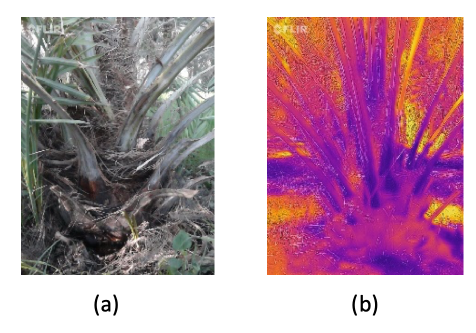
Figure 3: (a) Photo of a normal date tree and (b) the thermal heat distribution of the same palm tree by the IR sensor.
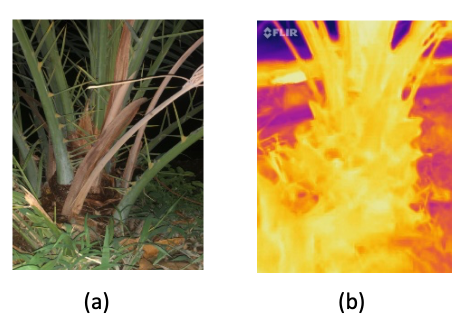
Figure 4: (a) Photo of RPW infestation case at night time and (b) the thermal heat distribution of the same palm tree by the IR sensor.
Since IR radiation has longer wavelength than visible band, thus it makes it difficult for humans to visualize IR thermal distribution. We can then utilize infrared sensors to inspect thermal distribution in palm trunk to detect any activities from the red palm weevil. IR images from healthy palm trunk were also recorded and processed for comparison purposes. Fig. 3 shows the temperature distribution within the trunk. As shown, the thermal heat distribution from the trunk was not significant enough, from which we could conclude that the palm is healthy. The heat distribution for the case of unhealthy trunk can be seen in Fig. 4 during night time, where more heat is expected from the trunk body itself.
Finally, the larva of the RPW was extracted. Interestingly, it was gluey. Additionally, it was observed that sufficient high radiated thermal energy was generated by the RPW and identified as yellow color from the sensor, as in Fig. 5(b).
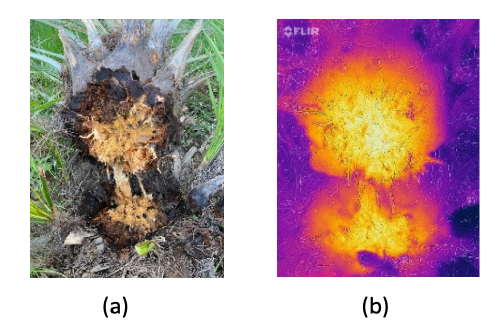
Figure 5: (a) Photo illustrating waste from infected palm trunk and (b) the thermal heat distribution of the same trunk by the IR sensor.
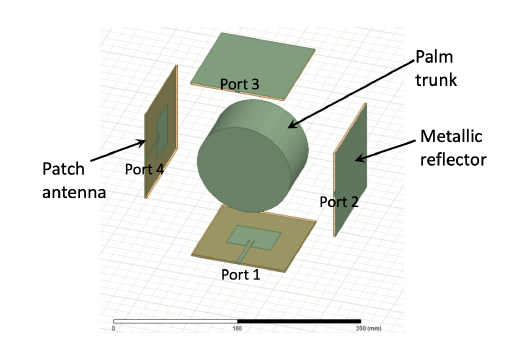
Figure 6: The developed model of the trunk surrounded with four microstrip antennas.
2.2. RPW sensing using microwave antennas
We investigate next the application of microwave-based sensors for red palm weevils detection. We have numerically modeled and simulated a small-scaled model comprising an unhealthy date palm and within its body a modeled pest. For ease of microwave sensing development, microstrip patch antennas are used here as the elementary sensors in order to predict any abnormalities within the coupled energy between the antenna elements. The spatial distance separating the radiating elements is maintained at 80mm. The modeled trunk has a height of 44.7mm and a diameter of 80mm (its dielectric constant, r = 31.5 and loss factor of 11.5). Since the solution to such 3D numerical model is mainly dependent on finite-element method of HFSS, storing the solution in each iterative process until convergence is reached would require huge amount of memory. To minimize the demands to such memory and disk space in the computer, a small-scale numerical model was constructed. Furthermore, the dimension of the RPW insect was modeled as a cylindrical object, with height = 2mm and radius = 3mm, with electric permittivity of 9.3 and bulk conductivity of 0.38 S/m. A single palm pest was placed in two different scenarios: within trunk’s center and edge side of the palm, as illustrated in Figs. 7 (a)-(b). Note that all aforementioned constitutive parameters and associated losses were embedded into the models [15].
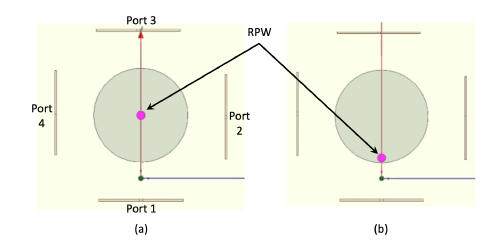
Figure 7: Top view of the trunk with a homogenized model mimicking RPW placed at two different scenarios, located at: (a) center, and (b) near to inner surface of the trunk.
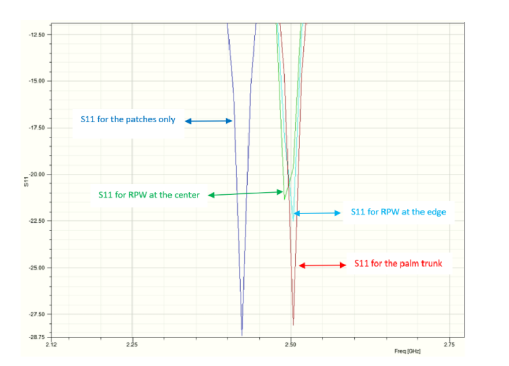
Figure 8: Simulated |S11| for the healthy and infected palm trunk.
For comparison, a finite size structure consisting of the four patch antennas was considered. The case of the four patch antennas alone, i.e. no palm trunk, is expected to provide good impedance matching and low coupling coefficients between the individual antenna elements. The case of a finite-sized healthy trunk (modeled here as cylindrical lossy object) was numerically simulated, with the four antenna elements surrounding the trunk, as illustrated in Fig. 7. Good matching for the microwave antenna elements is still maintained as shown in Fig. 8. Furthermore, an appreciable shift in the transmission coefficient between ports 1 and 3 (|S13|) was achieved, which is referred to the presence of RPW inside the palm trunk. It is worth mentioning here that no major frequency shift in the peak of |S13| was observed when comparing the cases of RPW at center and at the edge, as shown in Fig. 9.
The transmitted energy strength from port 1 to 4 was also considered. The sudden peak movement of |S14| for the unhealthy palm is expected, as depicted in Fig. 10. Furthermore, we note that transmission coefficient, |S13|, is stronger than that from ports 1 and 4, which is due to the strong mutual interaction from port 1 to 3 in comparison to the case of coupled energy from ports 1 and 4.
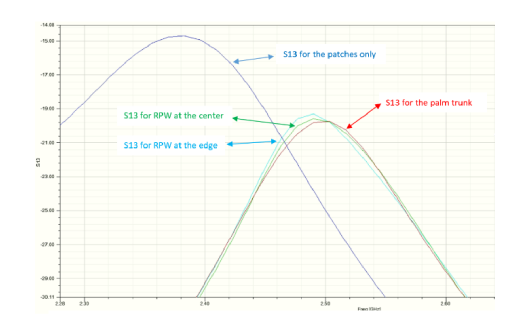
Figure 9: Simulated |S13| for the healthy and infected palm trunk.
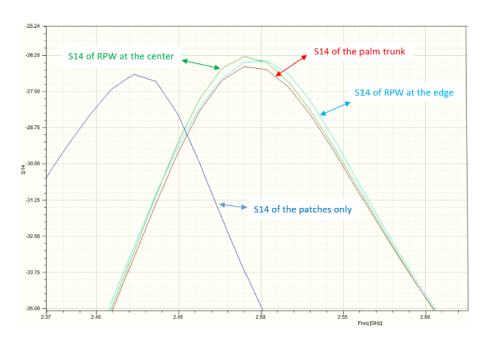
Figure 10: Simulated |S14| for the healthy and infected palm trunk.
2.3. RPW sensing using microwave TL-based metamaterial sensors
In this section, we present a numerical study of an interesting sensing modality using microwave transmission line-based metamaterial sensors. Such sensors are engineered resonant particles or unit cells that have found lots of applications from engineering and science. Amongst the popular structures is the artificial magnetic conductor, also known as split-ring resonator (SRR). The dual of the SRR is the complementary split-ring resonator (CSRR), i.e., artificial electric conductor [21]. A schematic representation of the physical structure of the two inclusions can be seen in Fig. 11, where square rings are depicted for convenience.
In this study, a single unit cell is presented for ease of demonstration and compactness of the sensor. However, it is also permissible that more concentric or cascaded resonant units as a 1 dimensional array of rings could be explored. Details of the dimensions of the SRR/CSRR inclusions include length of the ring represented by
L, a is the width of the SRR ring (or slot for CSRR), g is the cut gap and S p is the spacing between the two rings. From the physical operational point of view, the SRR resonates well once excited through a normal external magnetic field component, while the CSRR resonates very well through an external normal electric field. Interestingly, the dual-operation mechanism of SRR/CSRR is based on the Babinet’s principle, as presented in [21].
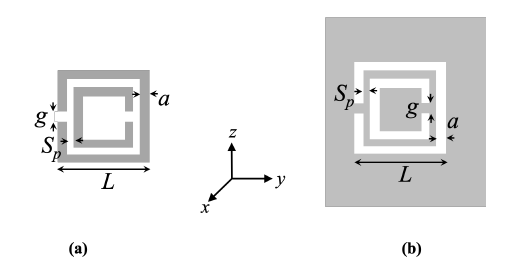
Figure 11: (a) the artificial magnetic conductor unit inclusion, and (b) its counterpart, the artificial electric conductor unit inclusion.
Fig. 12 depicts the developed microwave TL-based metamaterial structure. Two ports are deployed here in order to characterize the performance of the sensor through the computed transmission coefficient between the two ports. Once the sensing element is brought in close proximity to the date palm trunk, the resonance of the sensing element is expected to shift, and even further change is expected whenever RPW insects are within the inside of the trunk. The optimized dimensions of the developed CSRR microwave sensor at 2.45 GHz-band are available in Table. 2, along with the dimensions of the modeled 3D palm trunk.
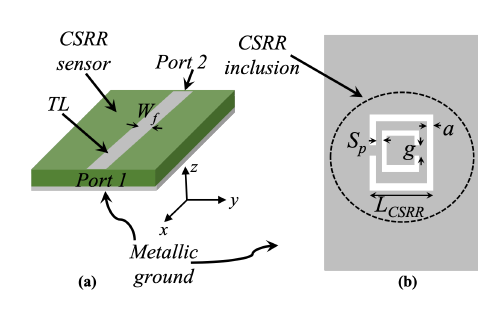
Figure 12: The developed TL-based metamaterial two-port sensor: (a) lateral view, and (b) bottom view of the metallic ground showing the adopted CSRR unit inclusion.
The grey area here represents metallization.
Table 1: A comparison between several existing techniques suitable for RPW infestation in palm trees.
|
Table 2: The optimized parameters of the microwave detection structure.
| Model parameters | Dimension(in mm) |
| Feedline width, Wf | 2.52 |
| Sensor thickness | 0.8 |
| Substrate length | 40 |
| Substrate width | 30 |
| Palm trunk diameter | 50 |
| Palm trunk height | 40 |
| Stand-off distance, S z | 2 |
| LCSRR | 10.5 |
| a | 0.45 |
| S p | 1.575 |
| g | 0.5 |
Fig. 13 shows a 3D view of the developed TL-metamaterial sensor that is placed on top of a date palm sample. For convenience, a stand-off distance, S d, of 2mm was considered. Coupled energy via the sensor’s ports is then computed and used as a metric to quantify the performance of the sensor in detecting RPW in date trees. Comparison was also made for the case of healthy palm trunk. Note that the resonance frequency of the reference sensor was 2.45 GHz. According to full-wave simulations, the close proximity of the sensor to a dry palm (representing dead one) resulted in a shift to the resonance frequency by 2.53% to lower frequencies due to the loss nature of the palm, while further increased shift to resonance frequency by 5.84% was incurred for the case of unhealthy (infected) palm tree.
Table. 1 provides a a comparison between several techniques that are available for the detection of infested date trees. It can be seen that each method has its own advantage and limitation, depending on various metrics.
3. Conclusion
In this paper, we presented a comparison study concerning the effectiveness of three detection techniques for red palm weevils in date palm trees. In the first detection method, detection of thermal variations within the date palm trunk was permissible using IR sensor. Experimental studies were performed in a small farm, containing a number of healthy and unhealthy palm trees. The experiments were carried out at different timings. Based on IR imagery data, quite noticeable heat was generated from the infested palm trees. A numerical model for the detection of RPW using four microstrip antenna elements working at 2.45 GHz was developed. Throughout the presented detection method using microwave antenna system and depending on the adopted number of ports, any sudden abnormalities in the response of either S11 or S21 magnitude and/or phase can be taken as an indicator for existence of RPWs in palm trunk.
Lastly, a 3D numerical model was developed for the case of deploying metamaterials-based microwave sensors. Based on the findings from this study, the two microwave-based detection models are considered as low-cost and effective tools for sensing the existence of RPWs.
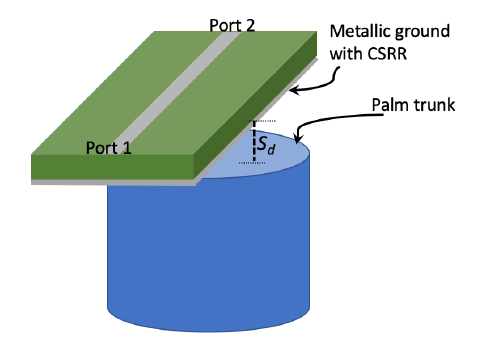
Figure 13: A 3D schematic showing the TL-based CSRR sensor in close proximity to a small-scale date palm trunk.
Conflict of Interest
The authors declare no conflict of interest.
Acknowledgment
The authors would like to acknowledge the support of Sultan Qaboos University, Oman, and Omantel company for providing the financial resources.
- T. Bosona, G. Gebresenbet“Food traceability as an integral part of logistics management in foo al supply chain,” Food Control, 33, 32–48, 2013, doi: 10.1016 02.004.
- K. G. Grunert, “Food quality and safety: consumer perception and demand,” European Review of Agricultural Economics, 32(3), 369–391, 2005, doi: 10.1093/eurrag/jbi011.
- J. Zhang, L. Liu, W. Mu, L. M. Moga, X. Zhang, “Development of temperature-managed traceability system for frozen and chilled food during storage and transportation,” Journal of Food, Agriculture and Environment, 7(3), 28–31, 2009.
- A.S. Al-Marshudi, “Oman traditional date palms: production and improvement of date palms in Oman,” Tropiculture, 20(4), 203–209, 2002.
- R. Al-Yahyai, M. Khan, Date Palm Status and Perspective in Oman, in: Al- Khayri, J., Jain, S., Johnson, D. (eds) Date Palm Genetic Resources and Utilization, 1st Edition, Springer, doi: 10.1007/978-94-017-9707-8-6.
- R. Al-Yahyai, “Improvement of date palm production in the Sultanate of Oman,” Acta Hort, 736, 337–343, 2007, doi: 10.17660/ActaHor- tic.2007.736.32.
- K. Azam, S. Razvi, I. Al-Mahmuli, “Survey of red palm weevil, (Rhynchopho- rus Ferrugineus Oliver) infestation in date palm in Oman,” Iraqi date Palms Network, http://www.iraqi-datepalms.net [accessed 4th October 2021].
- K. Al-Kindi, P. Kwan, N. Andrew, M. Welch, “Impacts of human-related practices on Ommatissus lybicus infestations of date palm in Oman,” PLoS ONE, 12(2), 1-17, 2017, doi: 10.17605/OSF.IO/HXPYP.
- D. Kontodimas,V. Soroker,C. Pontikakos,P. Suma,L. Beaudoin-Ollivier,F. Karamaouna,P. Riolo,“Visual identification and characterization of Rhyn- chophorus Ferrugineus and Paysandisia archon infestation,” in: Handbook of Major Palm Pests Biol. Management, 187-208, 2016, John Wiley and Sons, doi: 10.1002/9781119057468.ch9.
- E. Fear, S. Hagness, P. Meaney, M. Okoniewski, M. Stuchly, “Enhancing breast tumor detection with near-field imaging,” IEEE Microwave Magazine, 3(1), 48-56, 2002., doi: 10.1109/6668.990683.
- E. Fear, P. Meaney, M. Stuchly, “Microwaves for breast cancer detection?” IEEE Potentials, 22(1), 12-18, 2003, doi: 10.1109/MP.2003.1180933.
- S. Salem, “Accuracy of trained dogs for early detection of red palm weevil, Rhynchophorus ferrugineus Oliv. infestations in date palm plantations,” Swift
Journal of Agric. Res., 1(1), 1-4, 2015. - A. Hertzroni, V. Soroker, Y. Cohen, “Toward practical acoustic red palm weevil detection,” Computers and Electronics in Agriculture, 124, 100-106, 2016, doi: 10.1016/j.compag.2016.03.018.
- S. Nelson, “Review and assessment of radio-frequency and microwave energy for stored-grain insect control,” Transactions of the ASAE, 39(4), 1475–1484, 1996, doi: 10.13031/2013.27641.
- R. Massa, G. Panariello, D. Pinchera, F. Schettino, E. Caprio, R. Griffo, M. Migliore “Experimental and numerical evaluations on palm microwave heating for Red Palm Weevil pest control,” Scientific Reports, 7, 45299, 2017, doi: 10.1038/srep45299.
- F. Marzukhi, M. Said, A. Ahmad, “Coconut Tree Stress Detection as an Indicator of Red Palm Weevil (RPW) Attack Using Sentinel Data,” International Journal of Built Environment and Sustainability, 7(3), 1-9, 2020, doi: 10.11113/ijbes.v7.n3.459.
- H. Kurdi, A. Al-Aldawsari, I. Al-Turaiki, A. Aldawood, “Early detection of red palm weevil rhynchophorus ferrugineus (olivier), infestation using data mining,” Plants, 10(1), 95, 2021, doi: 10.3390/plants10010095.
- D. Kagan, G. F.Alpert, M. Fire, “Automatic large scale detection of red palm weevil infestation using street view images,” ISPRS Journal of Photogrammetry and Remote Sensing, 182, 122-133, December 2021, doi: 10.1016/j.isprsjprs.2021.10.004.
- M.M. Bait-Suwailam, “Numerical Assessment of Red Palm Weevil Detection Mechanism in Palm Trees Using CSRR Microwave Sensors,” Progress in Electromagnetic Research Letters, 100, 63-71, 2021, doi: 10.2528/PIERL21080303.
- F. Al Khanbashi, Nassr Al Nassri, M. Bait-Suwailam, “A Comparative Study of Electromagnetic-Based Sensing Modalities for Red Palm Weevil Detection in Palm Trees,” in: 3rd IEEE Middle East and North Africa COMMuni- cations Conference (MENACOMM), 69-73, 2021, doi: 10.1109/MENA- COMM50742.2021.9678240.
- F. Falcone, T. Lopetegi, M. A. G. Laso, J. D. Baena, J. Bonache, M. Beruete, R. Marque´s, F. Mart´ın, M. Sorolla, “Babinet Principle Applied to the Design of Metasurfaces and Metamaterials,” Physical Review Letters , 93(19), 197401, November 2004, doi: 10.1103/PhysRevLett.93.197401.
Citations by Dimensions
Citations by PlumX
Google Scholar
Crossref Citations
No. of Downloads Per Month
No. of Downloads Per Country
